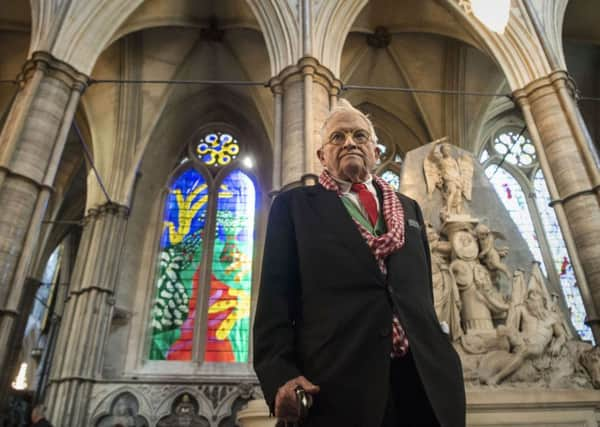David Behrens: A window into art jargon fails to shed light on David Hockney's Abbey tribute to the Queen


I went onto a website that generates random phrases which can be passed off as pretentious art criticism. I hoped it might help couch my feelings about the stained glass window created by David Hockney inside Westminster Abbey in language more scholarly than that which first came to mind.
So, with its assistance, I could argue that Hockney’s handling of light and his spatial relationships contribute to a broad critical dialogue.
Advertisement
Hide AdAdvertisement
Hide AdBut why dance around the issue? It looks like it’s been painted by a six-year-old – that’s the bottom line.
I’m not a complete Philistine, really I’m not. I like Hockney and his work. But etched in stained glass and cemented for all time in the North Transept of the Abbey, it looks plain out of place.
In case you haven’t seen it, let me attempt to describe it. By my reading, it depicts a Smartie tree and two bright yellow octopus tentacles, a few undersea plants and a big piece of red tissue paper. I have yet to encounter any of those items in the Yorkshire Wolds, whose landscape this is supposed to represent.
Advertisement
Hide AdAdvertisement
Hide AdIt is also intended as a statement on the Queen’s reign, the longest of any English monarch. Within the Abbey, it sits alongside other grand statements: the Christian story, as told in the panels of the Great West Window; the memorial to those who gave their lives in the Battle of Britain.
I would not go so far as to suggest that in this context, Hockney’s Queen’s Window is inappropriate, but neither does it sit comfortably.
We’re on dangerous ground here. The modern debate over what is and is not art, has been going on for 40 years – ever since the Tate bought 125 bricks in kit form, arranged them on the floor in a rectangle and, with the finesse of a hod carrier, passed them off as minimalist sculpture.
But I think it’s fair to say that the Hockney window is a surprise.
Advertisement
Hide AdAdvertisement
Hide AdIt had been suggested at the outset that his love for the landscape near his old house in Bridlington would be his inspiration, and indeed his more conventional painting of Woldgate Woods – the one that fetched £9.4m at auction in New York – would have looked stunning in stained glass, the light diffused through the trees.
I would love to know how far into the process he had got before telling the Dean of Westminster that the window wasn’t going to look like that. Did the Abbey insist on seeing early samples, or did it conclude that as Britain’s most successful living artist, he should have a free hand? And is the end result Hockney’s attempt at satire, or even subversion? We may never know.
The Dean, possibly using the same art critique website as me, said the window “reflected the Queen as a countrywoman” and that it was “popping with colour”, and compared to the plain one it replaced, that is certainly true. But Westminster Abbey isn’t the Tate and nor should it be. It is a sanctuary for respectful meditation, not radical experiment.
Hockney, of course, has form for confounding those who commission him. In the 1980s, he drew a similarly childlike impression for the cover of the Bradford telephone directory. A copy was distributed to every house in the city but they quickly became as rare as a working phone box, as collectors stashed them away for posterity.
Advertisement
Hide AdAdvertisement
Hide AdI love the idea that a corner of Westminster Abbey will be forever Yorkshire; I just wish that it was a Yorkshire I recognised. Still, what do I know? No-one has ever bid £9.4m for anything of mine. And, as Dr Catriona McAra, curator at Leeds Arts University, pointed out, Hockney’s work is no more abstract than the windows of Henri Matisse in his Rosary Chapel on the French Riviera. But the Matisse building is a plain white affair, distinguished only by its art, and the windows are of a uniform style. It’s the antithesis of Westminster Abbey.
So at the risk of appearing gauche, I must break ranks with Will Gompertz, the BBC’s arts editor and former director of Tate Media, who tweeted that the window was “rather beautiful, don’t you think?”
Striking it may be, and there is certainly a place for bright colours and thick, wobbly lines. But it’s the North Pier, not the North Transept.